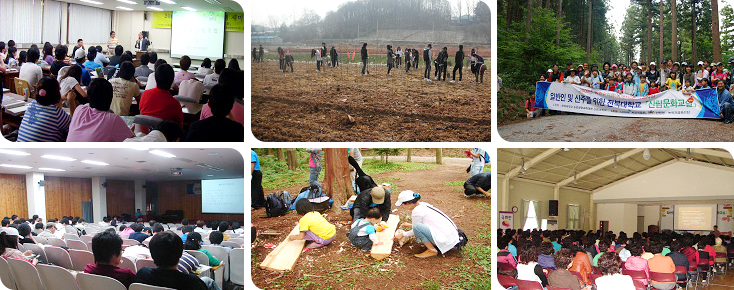Department of Forest Environmental Science
Introduction
The Department of Forest Environmental Science aims to cultivate highly skilled professionals who can acquire advanced knowledge in forestry-related disciplines and apply it in practice. Our curriculum covers a wide range of fields, including silviculture and practice, forest ecology, forest management, forest mensuration, forest pathology and protection, forest environment conservation, forest engineering, environmental forestry, forest recreation planning and design, forest policy, dendrology, forest genetics and breeding, and more.
To strengthen practical skills, the department operates affiliated academic forests with a total area of 2,159.53 ha: one in Deokjin-dong, Jeonju (153.02 ha), and another in Byeonsan Peninsula, Buan (2,006.51 ha). These forests provide comprehensive field training opportunities where students can combine theory with hands-on practice.
The Department of Forest Environmental Science was established alongside the College of Agriculture and Life Sciences at Jeonbuk National University. Since then, it has continuously expanded its educational and research facilities, evolving from the Department of Forest Resources into its current form.
Forests play a vital role in national economic development, land conservation, public health, and tourism through efficient and sustainable resource management. Our department educates future forestry specialists—managers, administrators, policymakers, and technicians—equipped with pride, vision, and expertise in modern forest science.
Educatinal Goals
What Do Students Learn?
Our curriculum includes a diverse set of courses that integrate theory with practice:- Silviculture & Practice 1, 2 – Techniques for artificial and natural regeneration, forest care, seed germination, photosynthesis, growth, and silvicultural applications.
- Environmental Forestry – The role of forests in improving environmental quality, pollution control, and recreation.
- Forest Surveying & Practice – Measurement techniques for distances, areas, and volumes used in forest planning and management.
- Forest Resources Mensuration & Practice – Methods for assessing biomass, tree volume, age, and growth.
- Forest Environment Conservation – Theories and practices of forest fire prevention, wildlife management, and tree surgery.
- Dendrology & Practice 1, 2 – Taxonomy, morphology, and identification of tree species.
- Forest Policy – The cultural and economic significance of forestry in national development and public welfare.
- Forest Management & Practice – Principles of sustainable management, harvest regulation, and forest planning.
- Forest Ecology – Interactions among trees, vegetation, and environmental factors.
- Forest Microbiology / Mycology – Study of forest microorganisms and fungi, with applications in biotechnology, food, and medicine.
- Forest Engineering – Road planning, forest operations, harvesting, and transportation systems.
- Forest Information Systems – GIS, remote sensing, and modern forest resource management tools
- Forest Genetics & Breeding – Principles of tree genetics, artificial pollination, and breeding programs.
- Forest Recreation & Design – Planning recreational forest areas for public benefit.
- Urban Forest Management – Conservation and planning of urban forests.
- Forest Growth & Yield Modeling – Predicting and analyzing tree and stand growth for scientific forest management.
- Wildlife Management – Ecology and conservation of forest wildlife.
- Forest Environment Restoration – Techniques for restoring degraded forest ecosystems and combating desertification.
- Forest Economics – Economic valuation of forest resources and environmental services.
- Special Use Tree Cultivation – Propagation and management of trees with special uses.
Through this comprehensive program, students acquire both theoretical knowledge and practical expertise to become leaders in forestry and environmental resource management.

